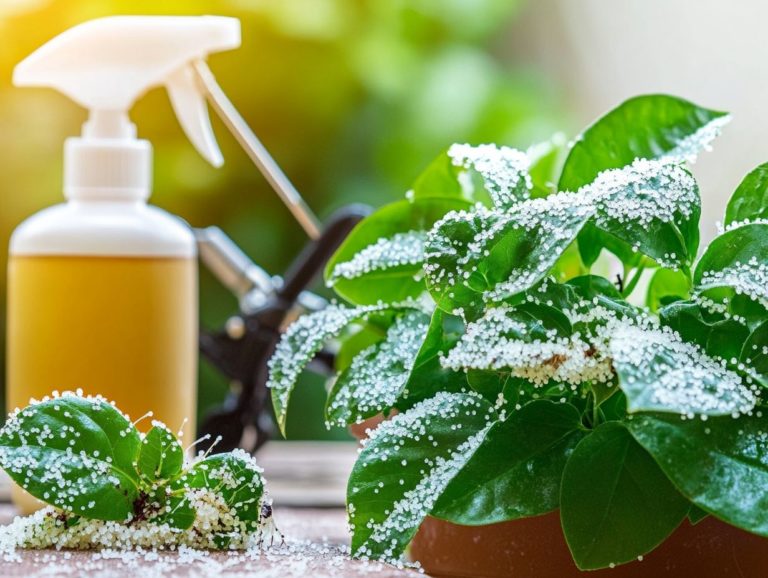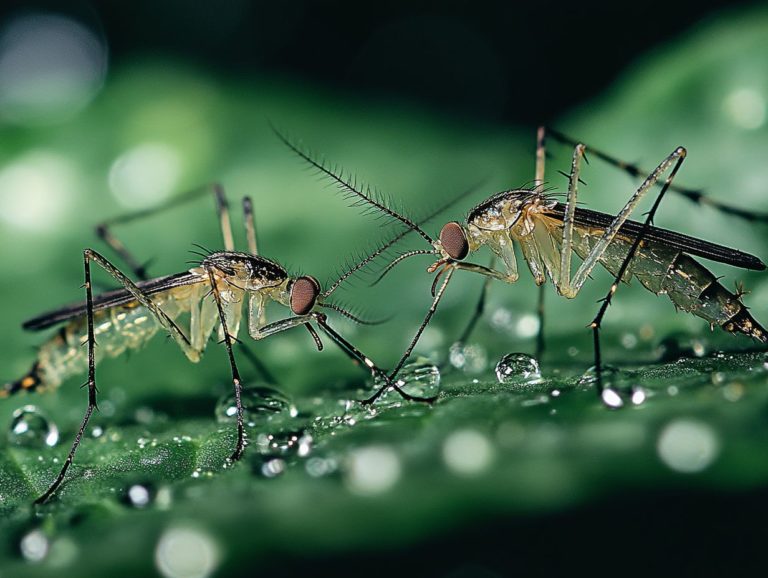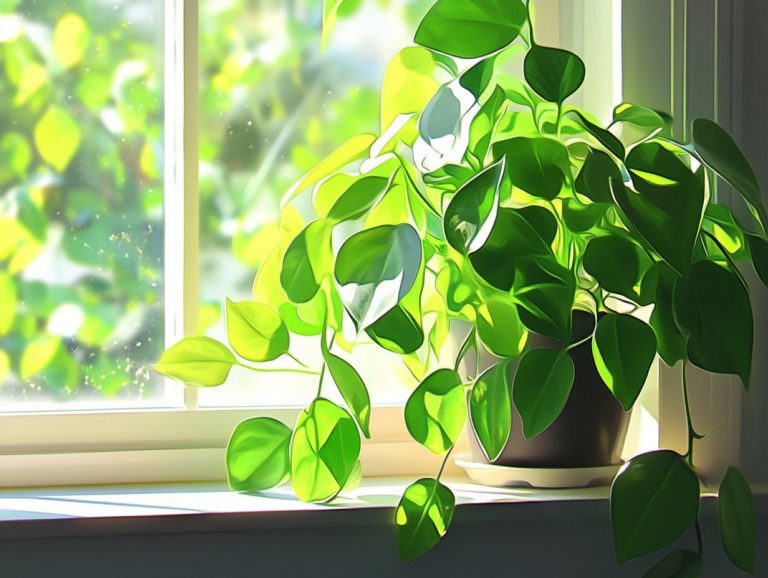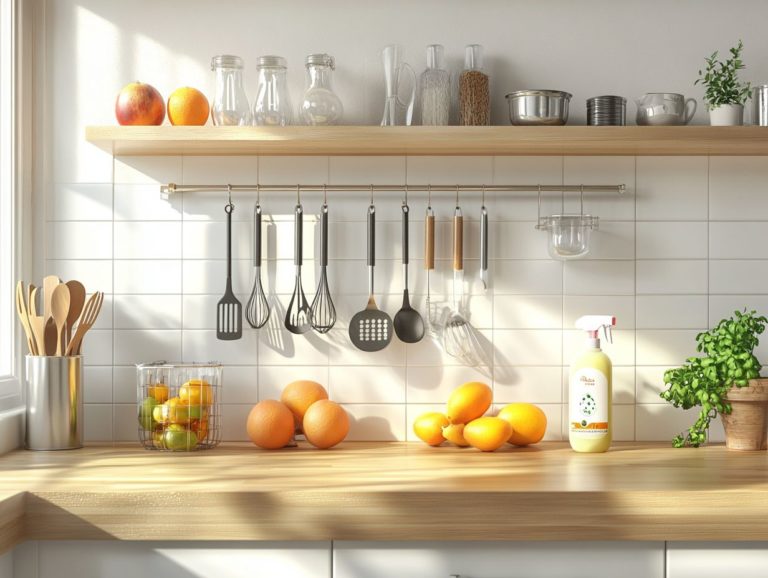Top 10 Pests That Affect Indoor Plants
Indoor plants bring life and beauty into your home, but they can also attract unwelcome guests. Tiny bugs like aphids and pesky caterpillars can cause significant harm to your green companions if not monitored closely.
Understanding the top ten common pests that target indoor plants is vital for maintaining their health and vitality.
This guide explores signs of infestation, effective prevention methods, and natural remedies to keep your plants thriving. Whether you re a seasoned plant parent or just starting your journey, you ll find valuable insights to keep your indoor garden vibrant and pest-free.
Contents
- Key Takeaways:
- 1. Aphids
- 2. Mealybugs
- 3. Spider Mites
- 4. Fungus Gnats
- 5. Scale Insects
- 6. Thrips
- 7. Whiteflies
- 8. Caterpillars
- 9. Slugs and Snails
- 10. Root Mealybugs
- How Do These Pests Affect Indoor Plants?
- What Are the Signs of Pest Infestation in Indoor Plants?
- How Can You Prevent Pests from Infesting Your Indoor Plants?
- What Are the Natural Remedies for Getting Rid of Pests in Indoor Plants?
- When Should You Seek Professional Help for Pest Infestation in Indoor Plants?
- How Can You Ensure Your Indoor Plants Stay Pest-Free in the Long Run?
- Frequently Asked Questions
- What are the top 10 pests that affect indoor plants?
- How do I identify aphids on my indoor plants?
- How can I control a mealybug infestation on my indoor plants?
- What are some natural remedies for treating spider mites on indoor plants?
- How can I prevent whiteflies from infesting my indoor plants?
- What are the signs of a thrips infestation on indoor plants?
Key Takeaways:
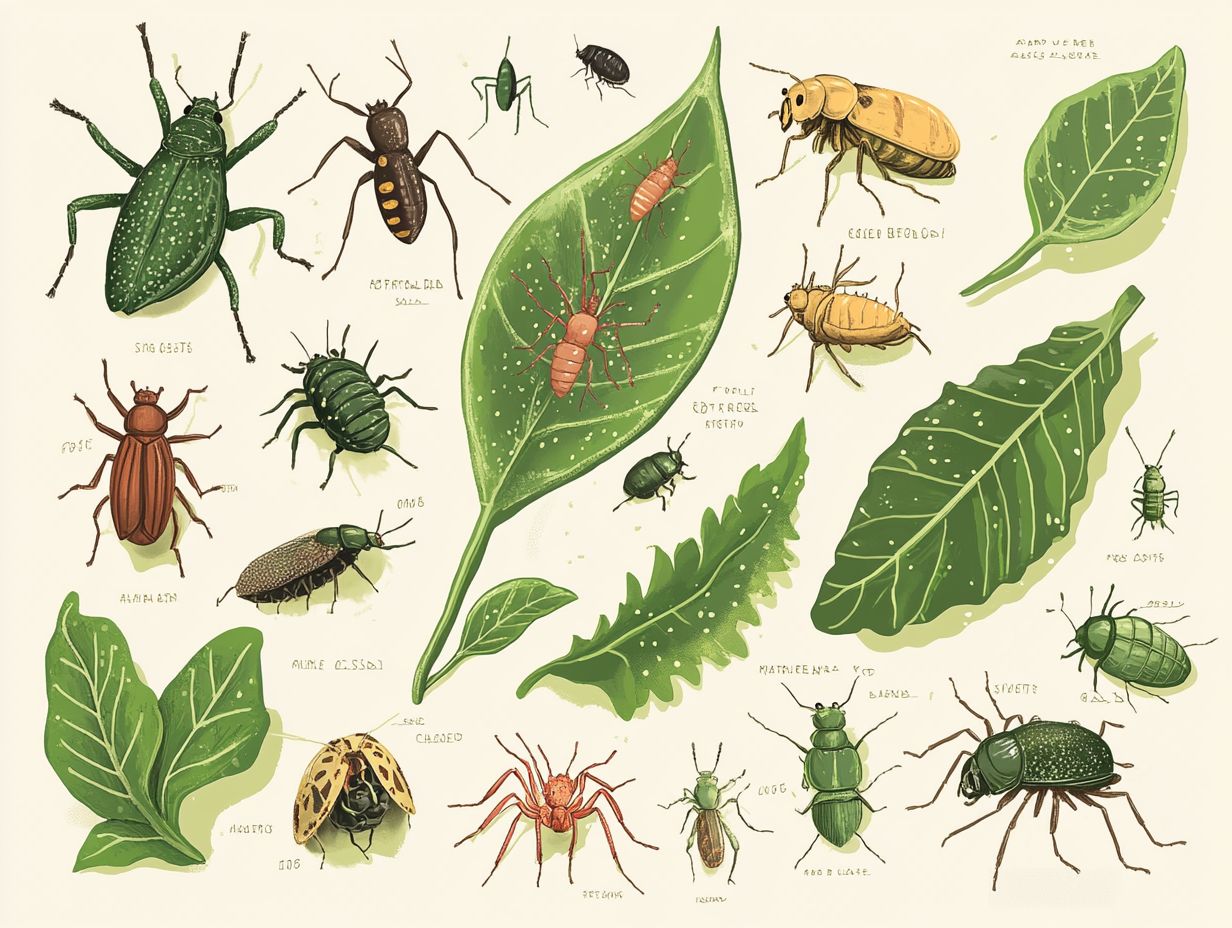
- Pests like aphids, mealybugs, and spider mites can harm indoor plants.
- Signs of infestation include yellowing leaves, sticky residue, and webs on plants.
- Prevent infestations by regularly inspecting plants, keeping them healthy, and using natural remedies.
1. Aphids
Aphids are small bugs that suck plant juice, posing a serious threat to your indoor plants. They often lead to infestations that can jeopardize plant health. These pests thrive in warm, humid environments, making them common in many indoor gardens.
Spotting aphids early is crucial. They typically gather on the undersides of leaves and new growth, causing foliage to distort or yellow. Their life cycle is rapid females give birth to live young, leading to a quick population boom.
Natural solutions like insecticidal soap (a safe way to kill pests) and neem oil effectively target these pests and are safe for most plants. These eco-friendly options are perfect for you! Regular watering and proper fertilization can also help keep aphids at bay, creating a more resilient indoor garden.
2. Mealybugs
Mealybugs can disrupt your indoor plants by feeding on their sap, leading to weakened growth. Identifying these pests early is essential; their cotton-like appearance is a clear sign for effective management.
These little pests often hide in leaf axils and the undersides of leaves, making thorough inspections necessary. As their numbers grow, they produce a sticky residue known as honeydew, attracting other pests and promoting the growth of sooty mold.
To combat these infestations, try organic pesticides like neem oil or insecticidal soap. These solutions tackle the problem without harming beneficial insects.
Establishing a routine for inspections and ensuring your plants are well-hydrated and properly spaced can help keep mealybugs away, allowing your indoor plants to flourish.
Start checking your plants today to keep them healthy and thriving!
3. Spider Mites
Spider mites are those tiny bugs that can cause serious problems for your indoor plants. They often lead to large infestations marked by unsightly webbing and speckled leaves.
These pests thrive in low humidity, making humidity control crucial for preventing their spread and keeping your indoor garden healthy.
Understanding the life cycle of spider mites is vital for managing them effectively. They reproduce quickly, with females laying hundreds of eggs in just a few days, leading to overwhelming population growth.
Their feeding habits can damage your plants, causing stunted growth and discoloration, which can harm your plants.
To combat this menace, increasing humidity can be a game changer. Spider mites prefer a dry environment, so consider misting your plants or using humidifiers to create a friendlier atmosphere for them.
Using insecticidal soap, which is soap that kills insects, can effectively suffocate these pests while remaining safe for your plants.
Taking proper care will supercharge your plants defenses against these pests! Providing adequate fertilization and ensuring airflow can enhance resilience against these unwelcome invaders.
4. Fungus Gnats
Fungus gnats are those pesky little flies that can harm your indoor plants. They lay their eggs in damp soil, and soon their larvae munch on your plant roots, leading to weakened plants that are more susceptible to diseases.
Finding these pests means your plants may be overwatered because their larvae thrive in moist settings. It’s crucial to keep a close eye on soil moisture levels.
Watch for signs of an infestation, such as adult gnats buzzing around your plants, yellowing leaves, or stunted growth.
To tackle these unwelcome guests, adopting proper watering techniques can significantly reduce their population. Allow the soil to dry out between waterings; this disrupts their breeding cycle.
Sticky traps can be your best friend, helping to catch those adult flies. By maintaining rigorous plant care, like regularly clearing away debris and ensuring good drainage, you can create an unwelcoming environment for gnats while promoting healthier plants.
5. Scale Insects
Scale insects are notorious for latching onto the stems and leaves of your indoor plants, feeding on sap and damaging them, which can lead to decline or even death if not addressed quickly.
Identifying these pests quickly is key to saving your plants! Proper identification allows for early intervention and effective pest control methods, ensuring the health of your indoor garden.
There are various types of scale insects, including soft scales and armored scales, each with unique characteristics. Their life cycle starts with the egg stage, progressing to a juvenile phase known as the crawler stage, where they are most mobile and can easily invade new plants.
Their feeding habits not only harm your plants but can also lead to sooty mold and attract other pests, like ants. Look for signs such as sticky residue or yellowing leaves to spot an infestation early.
When it comes to removal, you have several options. You can manually remove them with alcohol-dipped cotton swabs or apply horticultural oils. Each method has its place.
Organic pesticides can also effectively manage infestations when used correctly, allowing you to create a balanced approach to protecting and nurturing your indoor plants while being aware of the top 5 most destructive indoor plant pests.
6. Thrips

Thrips are tiny, slender pests that can wreak havoc on your indoor plants. They munch on leaves and flowers, leading to discoloration and distortion. This can ultimately jeopardize the health of your plants. Recognizing the symptoms of pest damage is crucial for maintaining the beauty of your indoor garden.
These little nuisances can be quite elusive due to their small size and knack for blending into their surroundings. They reproduce quickly, with females laying hundreds of eggs. This means that a minor issue can spiral out of control if you don t take prompt action.
Look for signs of their damage, including stippling on leaves, silvery patches, and annoying black specks of feces. Inspect your plant foliage regularly to catch any signs of damage early on!
Using insecticidal soap or neem oil can change the game. These methods target the pests directly while remaining gentle on your plants and beneficial insects. To ensure your plants thrive, be aware of the top 10 signs of a healthy indoor plant. Protect your indoor oasis with confidence!
7. Whiteflies
Whiteflies are pesky little winged intruders that can turn your indoor garden into a battleground. They happily feed on plant sap, leaving you with yellowing leaves and stunted growth. Effective pest identification and management are crucial for safeguarding your plants.
These pests typically follow a complete life cycle. They begin as tiny eggs laid on the undersides of leaves, then mature into young whiteflies that feast on your plants. Look for signs of their invasion, such as a sticky substance called honeydew, which can attract more unwanted guests and encourage the growth of sooty mold.
To tackle an outbreak, employ pest control methods. Consider organic pesticides like neem oil or insecticidal soap. Keeping your plants healthy through proper watering and nutrient management can help prevent whiteflies from moving in.
8. Caterpillars
Caterpillars, the larval stage of moths and butterflies, can pose a serious threat to your indoor plants. They munch through leaves and cause significant damage if not addressed swiftly. Raising your awareness about these pests and implementing effective control measures is essential for preserving your indoor garden.
Several types of caterpillars may invade your space, including the notorious cutworm and the vibrant armyworm. Each has its own unique feeding habits. Some prefer nibbling on young leaves, while others focus on the stems, leaving behind unsightly scars.
Manage these unwelcome guests using natural deterrents like neem oil or introduce beneficial insects such as ladybugs. These strategies can effectively reduce their numbers without jeopardizing your precious plants.
Regular inspections and maintaining optimal plant conditions are critical preventive measures to keep these ravenous feeders at bay.
9. Slugs and Snails
Slugs and snails can be a serious threat to your indoor plants, especially in humid conditions. They thrive and quickly munch through leaves and stems. Protect your indoor garden from these relentless invaders! Learn effective pest management techniques today.
These creatures aren’t merely nuisances; their slimy trails often reveal the extent of damage done to your delicate foliage. This can lead to stunted growth and compromised plant health. They particularly love younger plants, making prevention critical.
Implement various environmental practices to deter these pests. Ensure adequate air circulation and reduce humidity with proper watering techniques. Consider using barriers like copper tape or diatomaceous earth as physical deterrents.
By combining these strategies with regular monitoring, you ll cultivate a healthier, more resilient indoor garden, allowing your vibrant plants to thrive despite these persistent pests.
10. Root Mealybugs
Root mealybugs are sneaky little pests that can infiltrate the root systems of your indoor plants. They cause stunted growth and poor health if you don’t address the issue swiftly.
Implementing effective pest management strategies is essential for the vitality of your indoor garden and safeguarding against these hidden threats.
These pests reproduce at a fast rate, making their presence a significant concern for any plant enthusiast. You may notice early signs of an infestation manifesting as yellowing leaves, wilting, or an overall decline in your plant’s vigor. To effectively manage these issues, it’s important to identify the most common indoor plant pests as they feast on the roots, compromising nutrient and water absorption and drastically affecting growth.
Act fast to fight these pests! Use insecticidal soaps that effectively suffocate the mealybugs or opt for organic pesticides that are safer for your indoor environment. Additionally, be aware of the top 5 indoor plant diseases to watch for. Regular monitoring and swift action can help you maintain plant health and prevent any lasting damage.
How Do These Pests Affect Indoor Plants?
Pests like aphids, mealybugs, and spider mites can take a serious toll on the health of your indoor plants, causing stress that shows up as yellowing leaves, stunted growth, and diminished vigor. Understanding the interplay between these pests and your plants is essential for effective management and keeping your indoor garden thriving.
When these tiny invaders feast on plant sap, they undermine the plant’s ability to make food from sunlight, unleashing a chain reaction of physiological problems. Over time, this stress not only weakens the plant’s immune system but also makes it more vulnerable to diseases.
This is where the significance of regular inspections comes into play; catching and addressing pest issues early can save you from long-term damage. By implementing proactive pest control strategies be it through natural remedies or chemical treatments you can protect your plants’ vitality and promote robust growth, ensuring your indoor sanctuary flourishes without the threat of harmful intruders.
What Are the Signs of Pest Infestation in Indoor Plants?

Recognizing the signs of pest infestation in your indoor plants is essential for timely intervention and effective pest management. Symptoms can range from wilting leaves to sticky residue on the foliage, and early identification is key to preserving the health and vitality of your indoor garden.
Watch for common indicators like discolored leaves; these could signal nutrient deficiencies or the presence of unwelcome pests. You might also notice small webs or tiny specks that hint at spider mites or thrips lurking about. A sudden decline in plant vigor or unusual growth patterns can indicate hidden troubles beneath the surface, so it’s important to understand indoor plant pests and their impact.
To enhance your early detection, make it a habit to inspect both foliage and soil regularly. This awareness can help you catch issues before they escalate. Adopting practices such as:
- Maintaining optimal humidity
- Cleaning leaves to remove dust
- Rotating plants periodically
can significantly boost your indoor greenery’s resilience against infestations, ensuring it thrives in your care.
How Can You Prevent Pests from Infesting Your Indoor Plants?
Preventing pests from invading your indoor plants requires a blend of gardening expertise, environmental awareness, and attentive care to craft an unwelcoming atmosphere for unwanted guests. By taking proactive steps, you can cultivate a flourishing indoor garden that remains impervious to pest infestations.
Regular watering is essential; both over- and under-watering can leave your plants vulnerable, making them more prone to attacks. Keeping an eye on humidity levels is equally important, as many pests thrive in high humidity. It’s also a smart move to isolate newly acquired plants for a while, ensuring they’re pest-free before introducing them to your cherished collection. Additionally, consider using the top pest control products for houseplants to maintain a healthy environment.
Don t overlook the value of routine inspections and cleaning, as they can help you spot any early signs of infestations, allowing for swift action. By embracing these strategies, you contribute to a healthier indoor ecosystem, ensuring your plants not only survive but thrive.
Start today to keep your indoor garden thriving!
What Are the Natural Remedies for Getting Rid of Pests in Indoor Plants?
Natural remedies for eliminating pests in your indoor plants can be remarkably effective. By utilizing organic pesticides and simple household solutions like insecticidal soap, you can manage infestations without harming the environment. Embracing these eco-friendly pest control methods helps you protect your indoor garden while supporting sustainability!
Integrating natural solutions such as neem oil and diatomaceous earth can significantly enhance the health and resilience of your plants. Neem oil, derived from the seeds of the neem tree, disrupts the life cycle of common pests and serves as a fungicide, offering you dual protection. Diatomaceous earth is a powder made from tiny fossilized sea creatures that helps keep bugs away. You can sprinkle it around the base of your plants to deter crawling insects.
When applied thoughtfully and consistently, these remedies help create a thriving indoor ecosystem, ensuring that your plants flourish in a pest-free environment.
When Should You Seek Professional Help for Pest Infestation in Indoor Plants?
Determining when to seek professional help for pest infestations in your indoor plants can be tricky. Understanding the limits of home pest management techniques is crucial for maintaining the health of your greenery. If infestations persist despite your diligent efforts, contacting a pest management professional becomes essential to safeguard your indoor garden.
Certain signs can indicate that it’s time to bring in the experts. A severe infestation, marked by noticeable damage to leaves or a significant presence of pests, signals that action is needed. Pests like aphids, spider mites, and mealybugs multiply rapidly, making it challenging for DIY methods to keep them at bay. Additionally, it’s important to be aware of common misconceptions; you can learn more by checking out the top 7 indoor plant pest myths debunked.
When selecting a pest control service, consider their experience with indoor plants. Asking for recommendations or reading reviews can help ensure you choose an effective option. You can expect an initial assessment, followed by a customized treatment plan that may include both chemical and natural solutions to regain control of your indoor environment. It’s also helpful to be aware of the top 10 urban myths about indoor plant pests to make informed decisions.
How Can You Ensure Your Indoor Plants Stay Pest-Free in the Long Run?
Keeping your indoor plants pest-free over time requires ongoing maintenance and a proactive approach to pest management. By combining effective gardening tips with regular inspections and care routines, you can create an environment that minimizes the risk of pest infestations. Enjoy a vibrant indoor garden!
To achieve this, adopt consistent care practices such as proper watering, ensuring adequate sunlight, and maintaining soil health. These not only promote growth but also enhance your plants’ resilience against pests. Implementing environmental controls like regulating humidity and ensuring good air circulation creates conditions that deter unwanted invaders.
Equipping yourself with educational resources such as books, online courses, or local workshops provides you with the knowledge necessary for pest identification and organic treatment methods. This way, you re prepared to tackle any issues that might arise while nurturing your green companions.
Frequently Asked Questions
What are the top 10 pests that affect indoor plants?
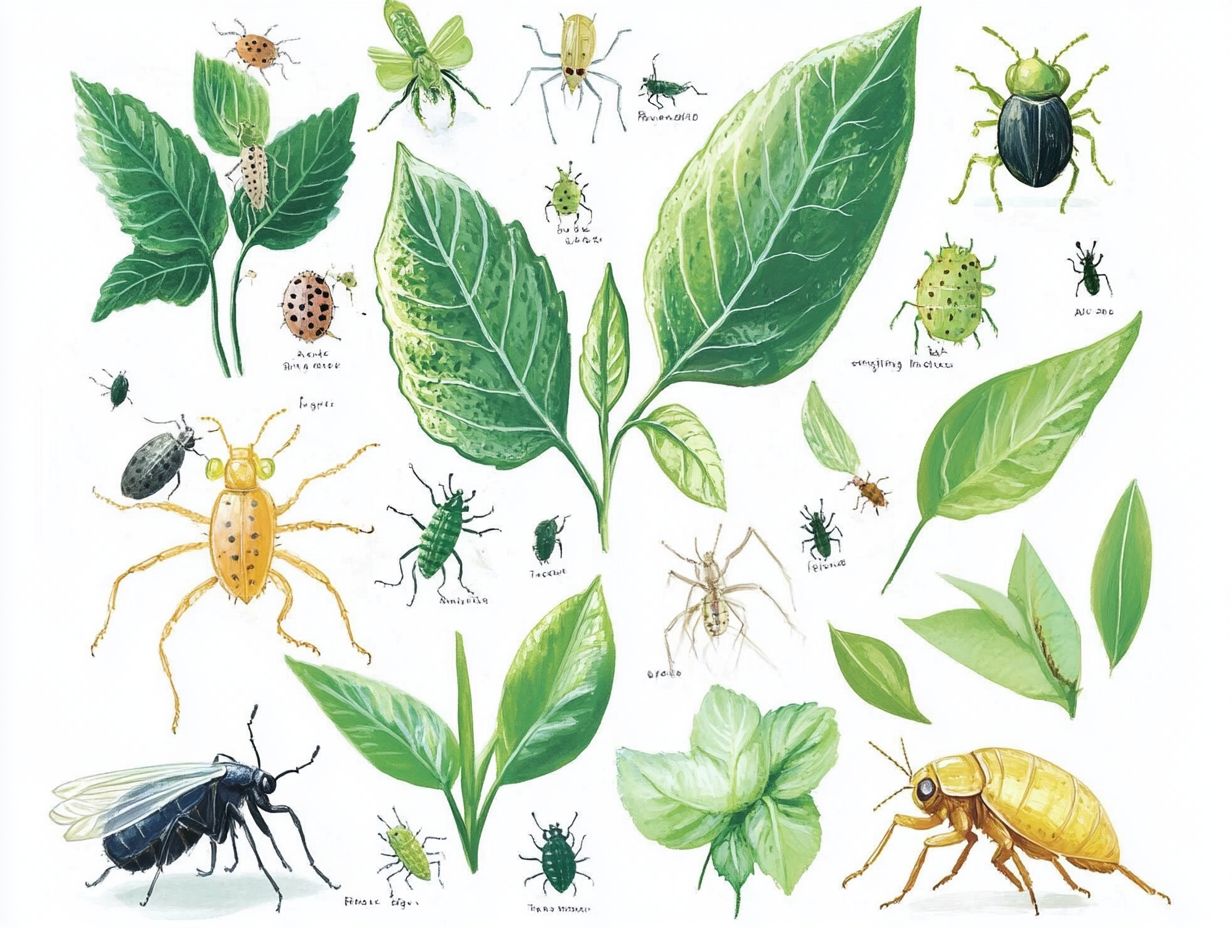
Understanding common pests such as aphids, mealybugs, spider mites, whiteflies, thrips, scale insects, fungus gnats, caterpillars, snails and slugs, and root ball pests is crucial for effective pest control.
The top 10 pests that commonly affect indoor plants include aphids, mealybugs, spider mites, whiteflies, thrips, scale insects, fungus gnats, caterpillars, snails and slugs, and root mealybugs.
How do I identify aphids on my indoor plants?
Aphids are small, pear-shaped insects that can be green, black, brown, or pink. They are usually found on the undersides of leaves and can be recognized by their sucking mouthparts and the sticky residue they leave on plant leaves.
Have you dealt with pests before? Share your experiences or tips below!
How can I control a mealybug infestation on my indoor plants?
To control a mealybug infestation, use a cotton swab dipped in rubbing alcohol. Bring in natural predators like ladybugs or lacewings to help manage the population.
What are some natural remedies for treating spider mites on indoor plants?
Try spraying your plants with a mix of water and neem oil. You can also use water mixed with dish soap or introduce predatory mites to manage spider mites.
How can I prevent whiteflies from infesting my indoor plants?
Keep your plants safe from whiteflies! Regularly clean the leaves and remove any nearby weeds or debris. You can also use yellow sticky traps to catch them.
What are the signs of a thrips infestation on indoor plants?
Signs of a thrips infestation include damaged leaves, silver streaks, and small black or brown droppings. You might also spot the thrips themselves tiny, slender insects with fringed wings.



